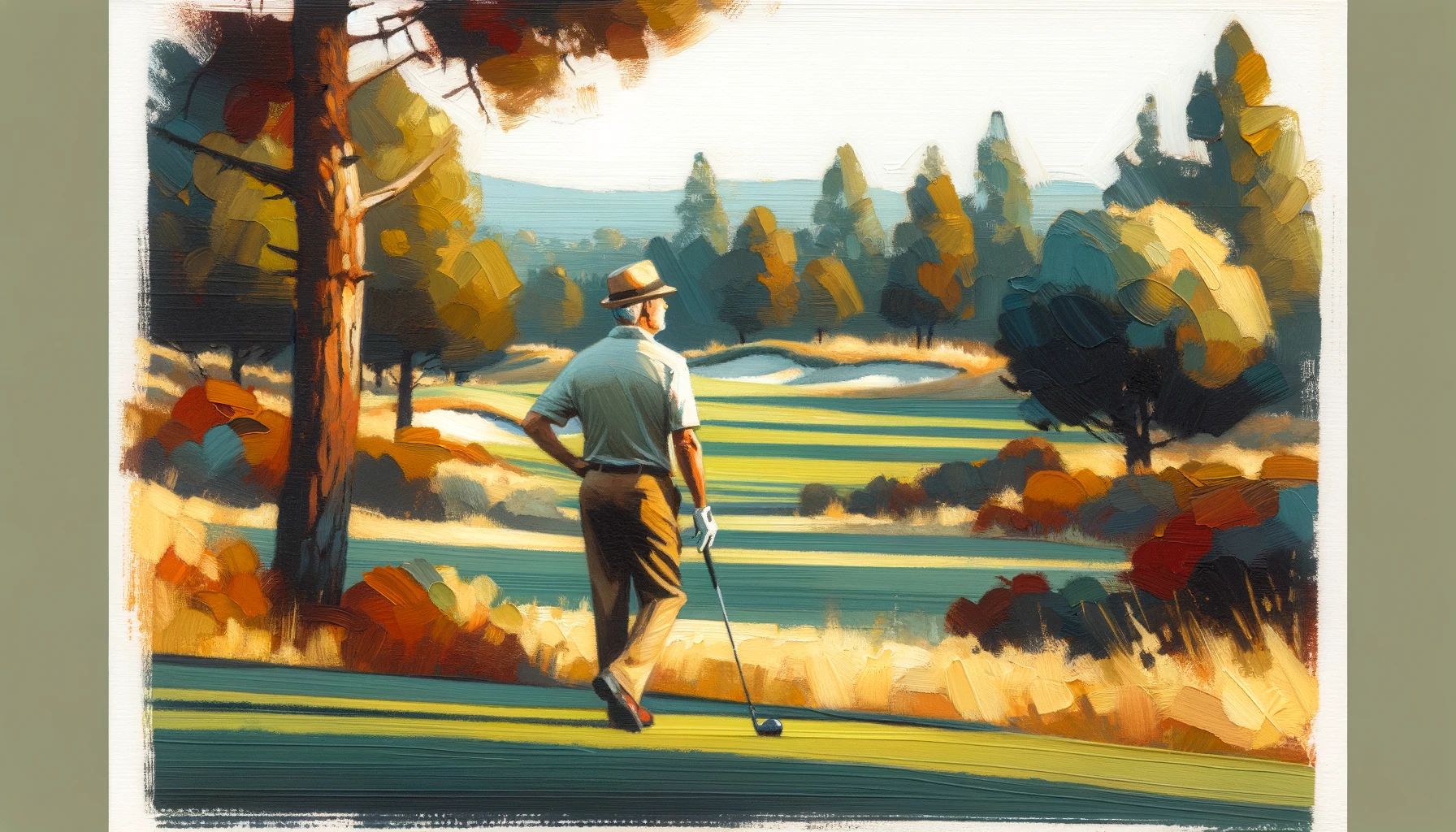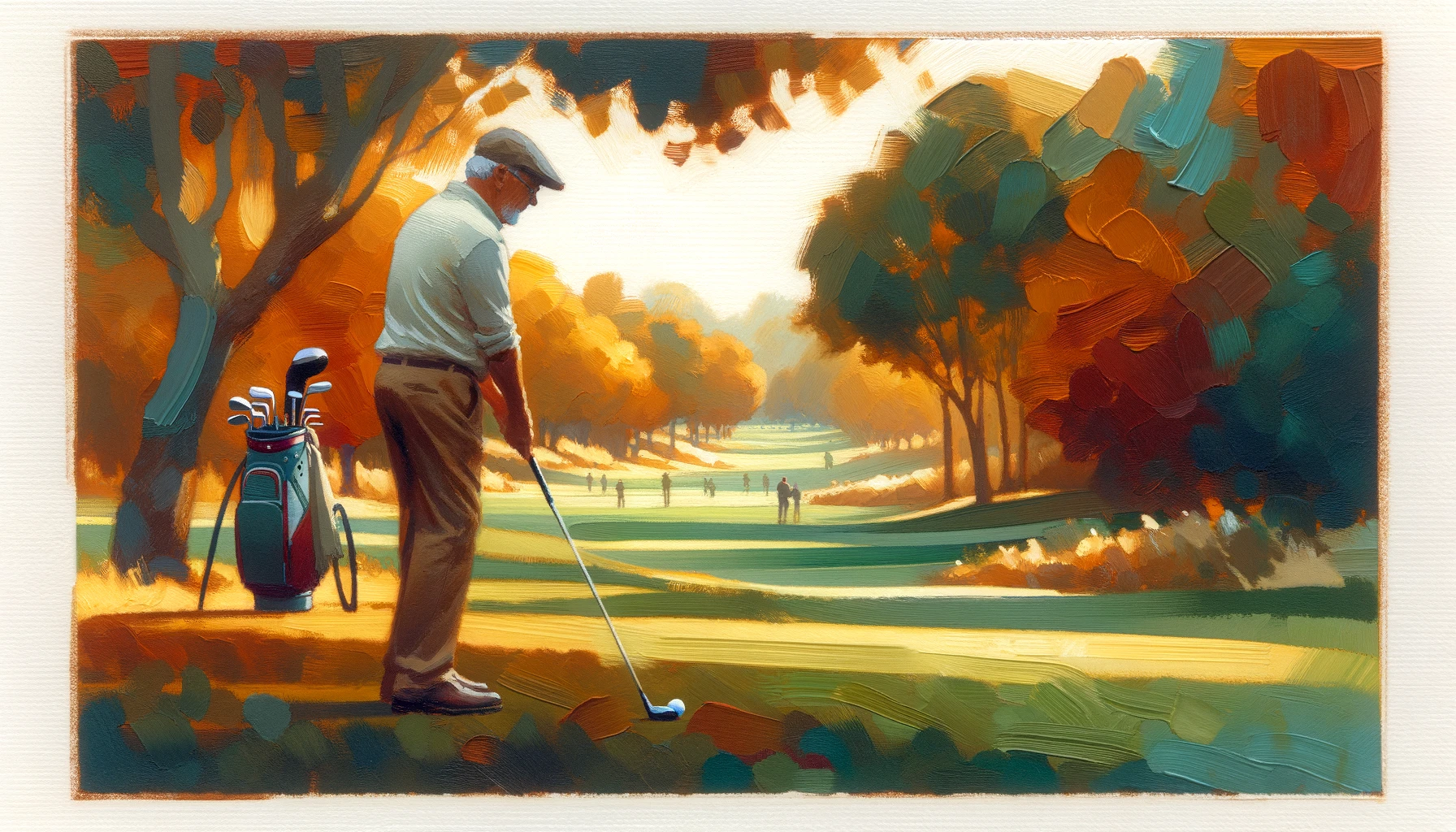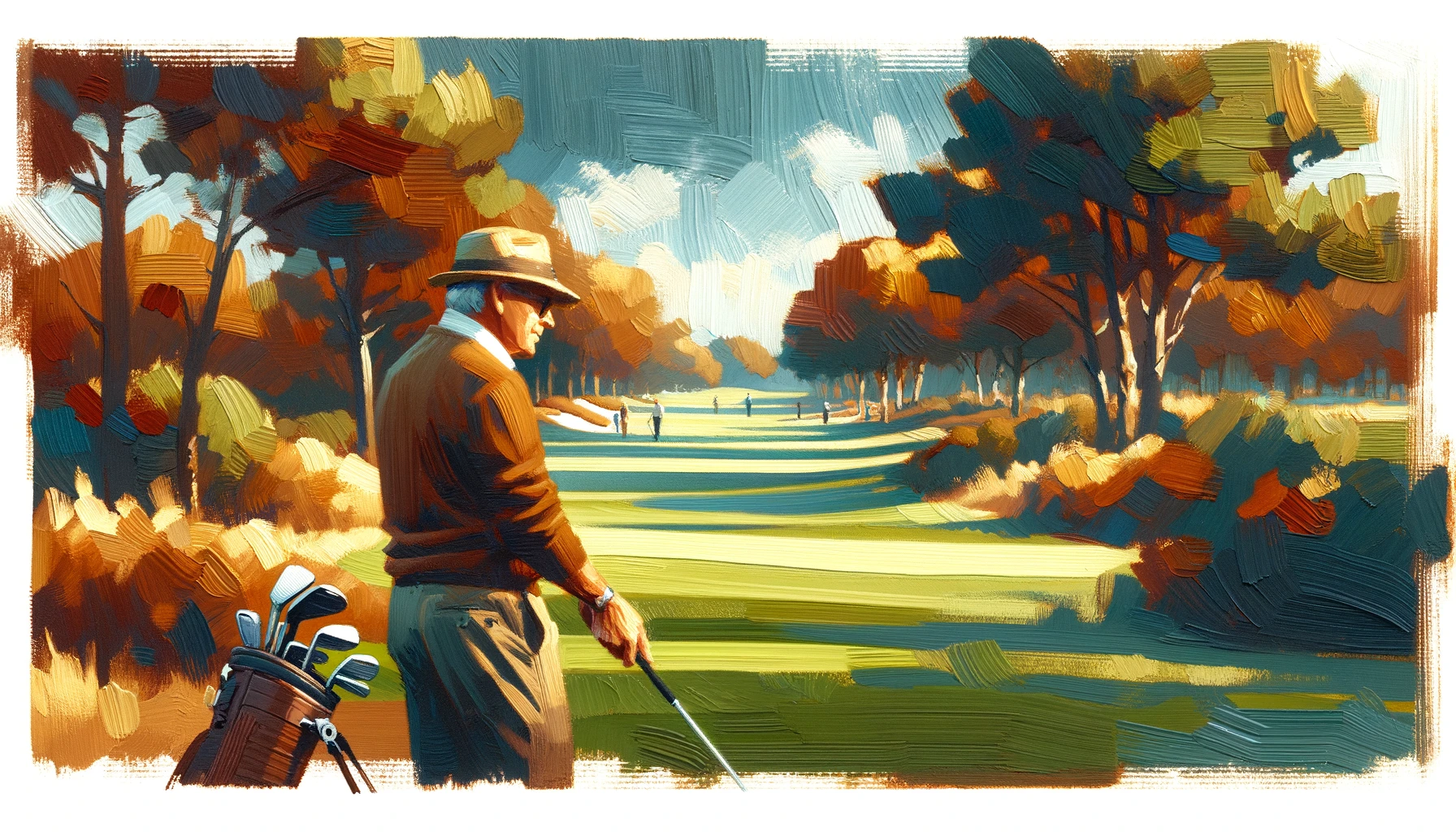The Weekend Golfer’s Guide to Dominating the Fairway
Embarking on the quest to master the art of the swing can feel daunting, but it's a journey well worth taking. This article distills essential strategies and insights, transforming weekend golfers into fairway masters. From selecting the right equipment to mastering course management and honing your swing, we delve into practical advice that promises to elevate your game. If you're pressed for time, jump to our key takeaways for a summary or our FAQ section for quick insights. Let's demystify the art of the swing together, making every round more rewarding and enjoyable.
It’s been said, "Golf is deceptively simple and endlessly complicated." As a golfer, you understand the endless quest for improvement, the thrill of a well-struck ball, and the frustration of a game that seems to slip just out of reach, just as you think you’ve nailed it. This journey, your journey, is not just about hitting a little white ball; it’s about unlocking the art of the swing to reveal your true potential on the golf course.
Now, I know this might not be your first time seeking advice to improve your game. And if past attempts have left you more bewildered than before, let me say, it’s not your fault. The golfing world is awash with conflicting advice, making it tough to find what works for you. Information overload can paralyze even the most determined golfer. But here's the thing: it’s okay. This confusion stops today.
If the fear of not being able to master your golf swing keeps you up at night, I’m here to put those fears to rest. You can and will succeed with the right guidance. Imagine standing on the first tee, confident and ready, knowing your drive will sail straight and true down the fairway. This can be your reality.
Those big golf brands, with their slick marketing and promises of instant success with the latest driver? They want you to believe that success comes from what’s in your bag, not from mastering the fundamentals. They’re wrong. Success in golf comes from understanding and applying the art of the swing, something that no amount of money can buy.
You might have suspected that there’s more to golf than what the mainstream media and the big brands tell you. You’re right. The secrets to a great game aren’t locked behind a paywall or reserved for those with a pro tour card. They’re there for you, too, if you know where to look.
And as for your dreams of walking off the 18th green with a score that you once thought impossible, I'm here to tell you that dream can be a reality. Together, we’ll embark on this journey, uncovering the secrets of the swing. Welcome to "Swing Secrets: The Weekend Golfer’s Guide to Dominating the Fairway."
 A serene moment on the course: the art of the swing in action.
A serene moment on the course: the art of the swing in action.The Golfer's Path to Mastery
My journey into the world of golf began not as a quest for mastery, but as a way to connect with friends and enjoy the outdoors. Little did I know, this casual interest would ignite a passion for the game and its intricacies.
As I spent more time on the course, my casual interest evolved into a quest for improvement. However, progress was slow, and frustration often overshadowed the joy of playing. It was clear that simply playing more was not enough to achieve the mastery I yearned for.
The turning point came when I came up with "The Golfer's Growth Journey: Fairway Mastery Blueprint." This framework offered not just techniques, but a holistic approach to mastering the game. It was a revelation that transformed my understanding and approach to golf.
The Blueprint outlined a 5-step system that focused on the art of the swing, course management, mental strategy, and the importance of the right equipment. It emphasized practice, learning, and enjoyment over competition, providing a structured path to improvement.
Following the Blueprint led to dramatic improvements in my game. Not only did my scores improve, but my enjoyment of golf reached new heights. I became a fairway master, competing with confidence and sharing my passion and insights with others. The journey transformed not just my game, but my life, enriching my relationships and expanding my social circle through golf.
Foundation First: Building Confidence on Easier Courses
Every journey begins with a single step, and in the world of golf, that step is understanding the foundational element of the game: the swing. The art of the swing is not just a phrase; it's the cornerstone upon which all of golf rests. But how does one start this journey? The answer lies in building confidence on easier, shorter courses and par-3 courses. Here's why and how.
Why Start with Par-3 and Shorter Courses?
When you're standing on the tee of a par-3 course, the green is in sight. There's a psychological advantage here; the target is clear, and the path is straightforward. These courses are designed not just for beginners but for any golfer looking to refine their swing without the intimidation of longer holes. It's about hitting that sweet spot, where confidence meets skill.
Playing on these courses allows you to focus on the mechanics of your swing - the grip, stance, and the swing itself - without the pressure of needing to cover vast distances. Each hole is an opportunity to practice and perfect, to understand how slight adjustments can lead to dramatically different outcomes.
The Role of Confidence in Applying Real-Game Skills
Confidence on the golf course is as crucial as any club in your bag. It’s the invisible asset that carries you through tough rounds. Building this confidence starts in the less daunting arenas of shorter courses where the stakes are lower, and the emphasis is on learning and enjoyment rather than competition.
As you progress, the lessons learned and the confidence gained on these beginner-friendly courses start to translate into tangible improvements in your game. You'll find yourself making decisions with greater ease, selecting clubs with more assurance, and approaching each shot with a calmness that comes from knowing you've practiced this before, just on a smaller scale.
A Lesson in Confidence
I remember a turning point in my own golf journey. It was a sunny afternoon on a small par-3 course. Up until then, I had struggled with inconsistency, my swings alternating between too timid and overly aggressive. But on this day, something clicked. I realized the power of a confident swing - not one burdened by overthinking the shot or the fear of failure, but a swing that felt natural, easy, and, most importantly, confident.
This epiphany wasn't about mastering a new technique or unlocking some secret skill. It was about understanding that confidence in my swing could only come from practice, and practice was best done in an environment that encouraged learning over winning. That day, I didn't just improve my game; I changed my approach to it.
The journey to mastering the art of the swing begins with building confidence, and there's no better place to do that than on easier, shorter courses. These courses provide a sandbox for experimentation, learning, and, most importantly, for understanding the true joy of golf. It's here, amidst the less intimidating fairways and greens, that the foundation of a great golfer is laid.
As we continue to explore the Golfer's Growth Journey together, remember: the goal is not just to play better golf but to enjoy the game in its entirety. After all, isn't that why we all started playing in the first place?
 Embracing the weekend warrior spirit with every swing.
Embracing the weekend warrior spirit with every swing.Score Less to Learn More: Prioritizing Learning Over Competition
In golf, as in life, the scoreboard isn't the only measure of success. Especially for weekend golfers embarking on the fairway mastery journey, the focus should pivot from competition to learning. It's about embracing every round as a learning opportunity, understanding that each shot, whether a drive, a putt, or a rescue from the rough, carries invaluable lessons.
Keeping Score the Right Way
Yes, keeping score is part of the game. It gives us benchmarks, goals to strive towards. But for those of us looking to truly master the art of the swing, it’s crucial to view those numbers through a lens of progress, not just performance. A high score doesn’t necessarily mean failure, just as a low score doesn’t guarantee success if it doesn’t come with understanding and improvement.
Consider keeping a "learning log" alongside your scorecard. Note not just the strokes but the story behind each hole. What worked? What didn’t? How did you feel? This approach turns every round into a lesson, not just a competition.
Learning from Every Shot: Practice and Enjoyment
Each swing on the course is a chance to learn. Did your drive land in the rough? There’s a lesson there in club selection or swing path. Missed a short putt? Perhaps it’s a cue to work on your putting stroke or to better read the green.
The real joy of golf comes from these moments of insight, from understanding the nuances of the game, and gradually seeing your efforts bear fruit. It transforms the game from a battle against the course to a journey of self-improvement.
Course Management Strategies: A Game Within the Game
Beyond the swing, there’s the strategy. Course management is about making smart decisions based on your skills and the situation. It's choosing the right club, knowing when to play it safe and when to take risks. This aspect of the game is often overlooked by beginners but is crucial for anyone looking to lower their scores.
A strategic approach to the game doesn’t just help you navigate the course; it sharpens your mental game. You start to see the course not as a series of obstacles but as a puzzle to be solved, with each decision building towards a satisfying conclusion.
Focusing on learning and practice over raw competition allows weekend golfers to develop a deeper understanding and appreciation of the game. It’s a shift in mindset, from playing to win to playing to learn. And as you embark on this journey, remember, the most significant victories often don’t appear on the scoreboard. They’re found in the moments of clarity, in the joy of a well-played hole, and in the satisfaction of knowing that with each round, you’re becoming not just a better golfer, but a true student of the game.
Mastering Course Management: Strategies for Every Golfer
The art of the swing is not just about how you hit the ball but also about making smart decisions before you even take the club back. This is where course management comes into play, a crucial skill set that separates the savvy golfer from the rest of the pack.
Choosing the Right Club: An Insight
It’s a common saying that golf is a game of inches, but it's also a game of choices, particularly when it comes to club selection. The right club can make all the difference in navigating the challenges of the course. It’s not always about distance; sometimes, accuracy or a particular shot shape is paramount. Understanding your own game—your strengths and limitations—is key to making these decisions.
For example, opting for an iron off the tee on a narrow par 4 might sacrifice distance but increase your chances of staying in play. Similarly, choosing a higher-lofted club for a tricky approach shot can provide more control and precision. These decisions might not always be the most aggressive, but they can lead to better scores and more enjoyable rounds.
Aggressive vs. Conservative Play: When to Decide
Knowing when to play aggressively and when to opt for a more conservative approach is a nuanced aspect of course management. It’s about assessing risk versus reward in real-time. This decision-making process is influenced by various factors, including your current score, the hole's difficulty, weather conditions, and even your mood.
A good rule of thumb is to be aggressive when you’re confident and the potential reward outweighs the risk, but conservative when the odds are not in your favor. Remember, one hero shot might save a hole, but consistent smart play will save your round.
Expanding Your Tactical Playbook
Course management also involves understanding the layout and features of the course. Each hole offers a unique challenge, and mastering these challenges requires a blend of tactical thinking and creativity. Don’t just see obstacles; look for opportunities. For instance, using the contours of the fairway to shape your shots or taking advantage of favorable pin positions.
This strategic layer of golf is often what draws players deeper into the game. It's a mental challenge that complements the physical aspect of swinging the club. As you develop your skills, you’ll find that thinking your way around the course is just as rewarding as mastering the perfect swing.
Course management is a dynamic and essential aspect of improving your golf game. By making informed decisions about club selection and when to take risks, you can play more intelligently and lower your scores. It's a skill that gets better with experience, so don't be afraid to experiment and learn from each round.
As we continue our journey through the Golfer's Growth Journey, remember that mastering the art of the swing is just one piece of the puzzle. Combining it with effective course management strategies will not only make you a better golfer but will also bring a deeper appreciation and enjoyment of the game. So, embrace these strategies, and watch as your game transforms on the path to fairway mastery.
 The journey to fairway mastery begins with a single swing.
The journey to fairway mastery begins with a single swing.The Weekend Golfer's Guide to Equipment: Maximizing Performance
Embarking on the fairway mastery journey isn't just about perfecting your swing or strategizing each play; it's also about understanding and choosing the right equipment. In the quest for lower scores and more enjoyable rounds, the weapons in your arsenal can play a pivotal role.
Insider Information on Golf Equipment
Let's dive into some insider information that could revolutionize your game. First off, not all equipment is created equal, and what works for the pros might not work for you. The key is customization. Today's technology allows for an unprecedented level of personalization in clubs, from adjustable drivers that can change loft and lie angles to irons tailored to your swing speed and style.
But it's not just about splurging on the latest and greatest. Sometimes, the most mega-valuable upgrades are the simplest. For instance, re-gripping your clubs can vastly improve feel and control, a small change with a big impact.
How the Right Equipment Can Transform Your Game
Imagine stepping onto the course with a set of clubs that feel like an extension of your body. Every swing is more confident, every shot more precise. This isn't just a fantasy; it's a very achievable reality with the right equipment.
One of the most wickedly effective pieces of advice I've received is to invest in a good fitting session. A professional fitter can assess your swing and recommend clubs that complement and enhance your natural game. It’s like having a custom suit tailored; the difference is palpable and can lead to head-shaking results.
The Hunt for the Perfect Equipment
The search for the perfect equipment is a journey in itself, a blend of science, art, and a bit of golfing heaven. It's easy to get lost in the mumbo-jumbo of technical specifications and marketing hype. My advice? Focus on feel and performance over brand names. The best club for you is the one that feels right in your hands and delivers the shots you need on the course.
Remember, the real thing in golf isn't just about having top-tier equipment; it's about having the right tools for your game. And when you find that perfect match, it's like unlocking a new level of play, where every drive is dead solid perfect, and every putt feels like it's destined for the bottom of the cup.
As we wrap up this segment of the Golfer's Growth Journey, remember that while the quest for the perfect swing is eternal, the equipment you choose can greatly influence your journey. It's about more than just aesthetics or following trends; it's about finding the right combination of tools that amplify your strengths and mitigate your weaknesses. So, embrace the hunt, and let the right equipment be the secret weapon in your quest for fairway mastery. After all, in the game of golf, being well-equipped is half the battle won.
Your Journey to Becoming a Fairway Master
As we reach the end of our journey through the Golfer's Growth Journey: Fairway Mastery Blueprint, it's clear that the path to becoming a weekend warrior on the course is both challenging and immensely rewarding. From unlocking the secrets of the art of the swing to navigating the mental and strategic aspects of the game, every step you've taken has been a building block towards fairway mastery.
Embracing the Golfer's Growth Journey
The journey doesn't end here. Like the game of golf itself, the pursuit of improvement is a lifelong endeavor. But with the insights and strategies we've explored, from prioritizing learning and enjoyment over mere competition to understanding the crucial role of course management and the transformative power of the right equipment, you're now equipped to tackle the challenges of the course with confidence and savvy.
The Importance of Community
Remember, golf is not just a solo journey. It's a social game, enriched by the community of fellow golfers you meet along the way. Sharing experiences, challenges, and triumphs adds another layer of enjoyment and learning to the game. As you continue to grow, consider how you can contribute to this community, sharing the insights you've gained and encouraging others on their own paths to mastery.
Looking Ahead: Continuous Improvement
As a golfer, you know that there's always room for improvement, whether it's refining your swing, discovering new strategies, or simply enjoying the game more deeply. The Golfer's Growth Journey is cyclical, not linear, with each round offering new lessons and opportunities to refine your skills and approach.
A Parting Thought
As you stand on the first tee, gazing down the fairway, remember that golf is a reflection of life: a mix of challenges and rewards, frustrations, and moments of sheer joy. Embrace each round with enthusiasm and a willingness to learn, and you'll find that the journey of improvement is as rewarding as the destination.
Thank you for joining me on this journey. May your drives be long and straight, your putts true, and your love for the game everlasting. Onward to fairway mastery!
 Where experience meets passion: the golfer's bliss.
Where experience meets passion: the golfer's bliss.Key Takeaways: Mastering The Art of the Swing
- Start Small and Build Confidence: Begin your golfing journey on easier, shorter courses and par-3 courses. These settings are perfect for applying skills in a real-game context without the pressure of more complex courses.
- Learning Over Winning: Keep score to track progress, but focus on learning, practicing, and enjoying the game rather than just competing. Every round, every shot, is a chance to learn something new.
- Smart Equipment Choices: Invest in equipment that suits your style and skill level. Custom fitted clubs can be a game-changer, helping to improve your swing and overall game performance.
- Course Management: Mastering the art of the swing isn't just about how you hit the ball; it's also about making smart choices on the course. Practice deciding when to play aggressively and when to opt for a more conservative approach.
- The Golfer's Growth Journey: Embrace the Fairway Mastery Blueprint, a systematic approach to transforming your game, enriching your life, and expanding your social circle through golf.
Here's the tough truth you probably already know. If you want different results, you need to do something different. Make a definitive decision right now to get different results. This journey, The Golfer's Growth Journey: Fairway Mastery Blueprint, is not just a path to lower scores and better rounds; it's a gateway to a new you, a golfer who approaches the game with confidence, strategic savvy, and a deep enjoyment of every moment on the course.
Choosing to embark on this journey means choosing to leave behind old habits, old frustrations, and the limits of your current game. It's a decision to embrace a new approach, one that prioritizes growth, learning, and the sheer joy of golf. So, as you stand at this crossroads, ask yourself: Are you ready to choose the path that leads to new heights in your golf game? Are you ready to master the art of the swing, to play with confidence and joy? The choice is yours, and the time is now. Onward to mastery, to new challenges, and to the incredible rewards that await on the other side.
FAQ: Mastering The Art of the Swing
What is the art of the swing in golf?
What is the art of the swing in golf?
The art of the swing refers to the complex, nuanced technique of executing a golf swing, integrating aspects of physical posture, mental focus, and precise movements to hit the ball effectively.
How can I improve my golf swing?
How can I improve my golf swing?
Improving your golf swing involves practice, understanding of fundamental techniques, and often guidance from experienced players or coaches. Focusing on posture, grip, and alignment can yield significant improvements.
Is it necessary to use expensive equipment to master the art of the swing?
Is it necessary to use expensive equipment to master the art of the swing?
No, mastering the art of the swing is more about technique and practice than expensive equipment. Properly fitted, reasonably priced clubs can be just as effective as high-end options.
What are common mistakes in executing a golf swing?
What are common mistakes in executing a golf swing?
Common mistakes include incorrect grip, poor stance and alignment, lack of focus on the target, and inconsistent swing speed. Addressing these can dramatically improve your swing.
How often should I practice my golf swing?
How often should I practice my golf swing?
Consistent practice is key. Even short, regular practice sessions can be more beneficial than infrequent, long sessions. Aim for at least 3-4 times a week.
You're probably thinking you need natural athletic ability to master the art of the swing, right?
You're probably thinking you need natural athletic ability to master the art of the swing, right?
Well, many golfers have improved their swings significantly through practice and technique adjustments, regardless of their athletic background.
You're probably thinking that mastering the art of the swing takes years, right?
You're probably thinking that mastering the art of the swing takes years, right?
Actually, with focused practice and the right guidance, significant improvements can be made in a much shorter timeframe.
Can golf swing trainers help improve the art of the swing?
Can golf swing trainers help improve the art of the swing?
Yes, swing trainers can be a valuable tool for reinforcing good swing habits, muscle memory, and alignment. They complement on-course practice and instruction.
What is the best way to learn the art of the swing?
What is the best way to learn the art of the swing?
The best way involves a combination of professional instruction, self-study, and practice. Tailoring this approach to your learning style can accelerate your progress.
You're probably thinking that you can't improve your swing because you're not strong enough, right?
You're probably thinking that you can't improve your swing because you're not strong enough, right?
Well, the art of the swing is more about technique and timing than raw strength. Many players with less physical power excel with efficiency and precision.















